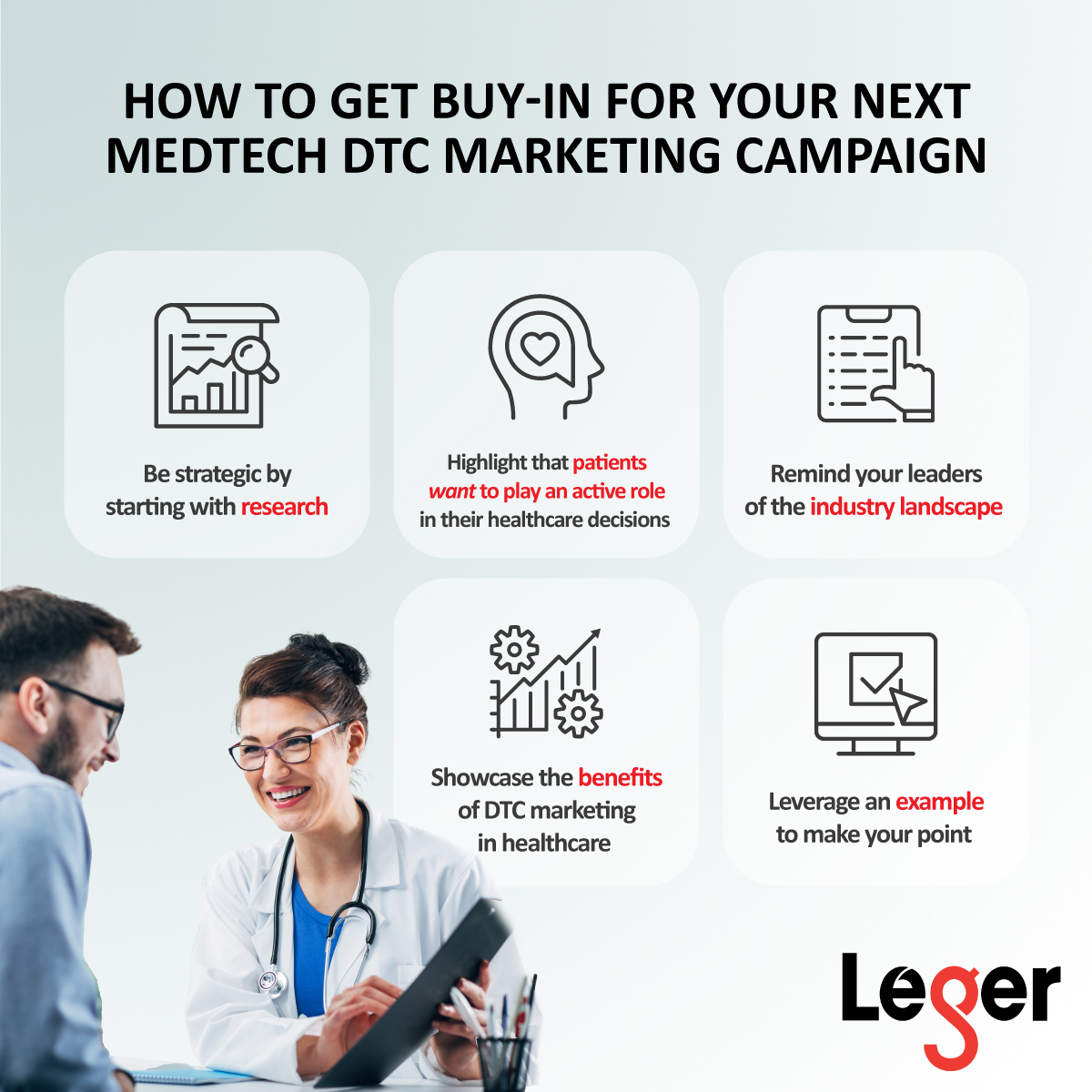Brands that do not consider DTC marketing risk losing share to those who do, which is why it’s so important to ensure that you have the tools in place to develop a solid strategy, get buy-in from internal stakeholders, and build a strategic, data-driven campaign.
This article is the second in a series of three articles focused on helping you build a successful DTC campaign for your target market. Our first article explored why delving into the emotional side of the patient journey is the ideal place to start. This article focuses on how to get buy-in and internal support, and the final article in the series will go into depth on how to build a successful DTC marketing campaign in the healthcare space.
Innovative medical device companies are already using DTC marketing
With Americans wanting to play a more active role in their healthcare journeys, there are many opportunities to influence the products they prefer (even in areas where they don’t choose the products themselves—see how!).
With a few exceptions, such as diabetes monitoring devices, the medical device industry has not typically engaged in DTC marketing. The prevailing thought is that it doesn’t make sense to market to patients when physicians or hospitals are the primary purchasing decision-makers.
However, industry trailblazers are implementing DTC campaigns in untraditional areas and seeing benefits, such as increased share and greater demand for their specific devices or unique device features. For example, Hologic and GE HealthCare, two companies in the diagnostic imaging market, always deemed a market in which DTC does not make sense, have created innovative DTC ads that speak to the value of these campaigns and show the importance of thinking beyond preconceived ideas.
Hologic: In this video ad, the company markets its Horizon® DXA System’s bone mineral density scan to prevent osteoporosis. It encourages viewers to talk to their doctors about osteoporosis risk factors and find a list of facilities that offer this scan.
GE HealthCare: This dynamic, fast-moving campaign, highlights how the company is innovating to bring care to patients. It ends with a doctor showing a pregnant woman an ultrasound picture of her fetus on a cell phone.
The sooner you can infuse thoughts of your product into patients’ decision-making processes, the more opportunities there are for you to increase your share and grow.
Example: How to use DTC marketing for medical products patients don’t choose
Innovative companies are getting ahead by using DTC marketing in untraditional ways.
To see how this could work, let’s look at an example where DTC marketing traditionally wouldn’t be used: for large joint implants (which are traditionally chosen by surgeons or hospitals).
A medical device company that produces large joint implants with chemical properties that promote faster bone healing and tissue integration could create a DTC marketing campaign to educate and empower patients so they understand how quickly they can get back to doing what they love—playing golf, keeping up with their grandchildren, even running marathons—can be impacted by the brand of implant they get.
When patients understand that different brands of large joint implants can lead to different outcomes, over time, the conversation at the doctor’s office shifts from the patient saying, “I want to recover quickly,” to “I want this brand of implant.”
With enough patient interest, doctors will talk to surgeons, who will talk to hospitals about the type of implants that are in demand. This process takes time, and brands who develop effective DTC marketing campaigns sooner rather than later are more likely to get (and stay) ahead.
How to get buy-in for your next DTC marketing campaign
In the healthcare industry, we’ve already seen a shift in terms of what is most important. First, it was all about volume (in that more procedures led to more revenue for hospitals and more devices purchased). Then, it was all about costs (the lower the cost, the higher the profit for hospitals).
Today, understanding the patient experience is critical. The better the patient experience, the better the outcomes, which leads to more reimbursement for hospitals whose outcomes improve. If your device helps enhance the patient experience and improve outcomes, you can position yourself in alignment with hospitals’ goals, while delivering better patient outcomes and becoming more desirable than low-cost competitor devices.
Now that you know the value of DTC marketing in the healthcare space, how can you most effectively transmit this knowledge to get buy-in from leaders at your organization?
Be strategic by starting with research
Completing patient journey mapping and understanding the emotional side of the patient journey will help you identify key points where DTC marketing may help you grow your market. You can also leverage market research in the form of surveys or online communities to help get a better view of the patient landscape and generate additional proof points.
Activating your campaigns where patient consideration is highest will enable you to be more strategic and avoid wasting valuable advertising time and dollars at the wrong stage of the patient journey. Better yet, you can have patients considering your brand before they think of your competitors.
Highlight that patients want to play an active role in their healthcare decisions
Recent Leger stats reveal that more than 60% of Americans notice ads related to symptoms or a condition they’ve searched for online. In addition, 62% of Americans want to collaborate with their doctor to determine the best way to manage their health.
Rather than focusing your marketing efforts solely on doctors and hospitals, highlight that your company can use a DTC marketing campaign to highlight the benefits of your products to the ones who may live with them for a lifetime: patients.
Remind your leaders of the industry landscape
In the increasingly competitive healthcare space, companies that use DTC marketing are succeeding in untraditional spaces. Your company can leverage DTC marketing as a tool to steal and increase share: if it doesn’t, it risks getting left behind.
Showcase the benefits of DTC marketing in healthcare
Some of the key ones you can mention are:
- Using it helps increase awareness of your value proposition and the key attributes that differentiate your product from your competitors’ products
- It can help improve patient outcomes and reduce the risks associated with low-cost alternatives
- It empowers patients to take a more active role in their health, leading to positive associations with your brand
- It has the potential to reduce the economic impacts of complications (such as post-surgery infections), improving perceptions of your brand at hospitals
Leverage an example to make your point
Feel free to use our example above about large joint implants or customize it for your brand.
Don’t miss the next article in our series, which will go into depth about how to create a successful DTC marketing campaign.
Speak to our medical device experts
To start conducting patient journey research, or to explore other market research that can help you get buy-in for your next campaign, contact us by filling in the form below.



